Sony XR-55A95K Review
Yes, it’s OLED - but it’s Quite Different
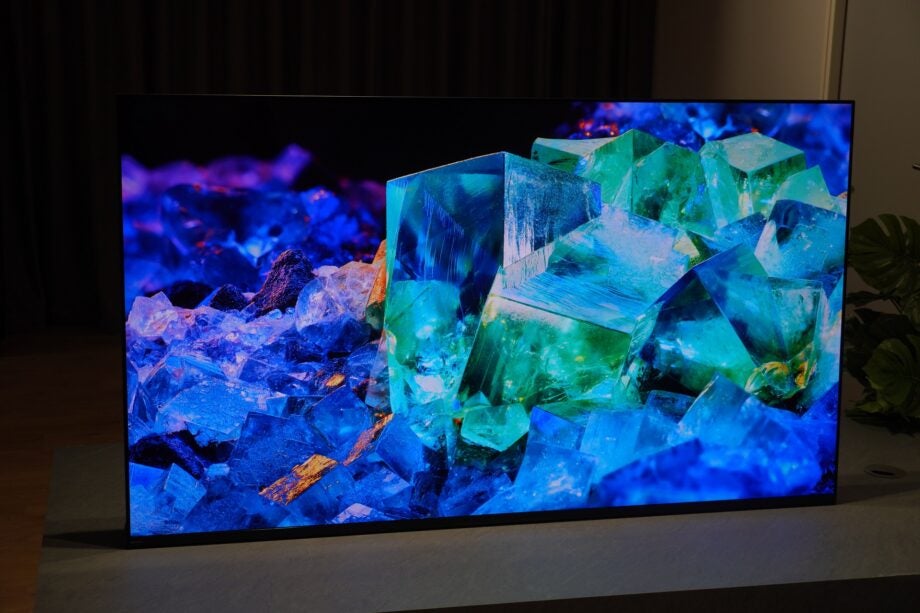

Verdict
The Sony XR-55A95K doesn’t change the OLED game but it moves it forward a distance, and that will do us for now
Pros
- bright, detailed and balanced images
- fine sound
- good upscaling (up to a point)
Cons
- Unarguably expensive
- Only incrementally brighter than LG’s brightest OLED
- Bravia Cam seems gimmicky
Key Features
- Google TV smart interfaceSupports a wide array of apps
- HDMI 2.1 VRR, ALLM and 4K/120Hz support
- SoundTwo rear-firing subwoofers
Introduction
For every TV innovation that’s proved itself (like OLED technology or 4K resolutions), there’s a technology that’s been roundly ignored (like 3D technology or curved screens). Place your bets now on QD-OLED, ladies and gentlemen.
QD-OLED is a Samsung innovation. You know, the same Samsung that until very recently couldn’t even bring itself to utter the word ‘OLED’. By combining elements of OLED with its own QLED quantum dot technology, Samsung reckons it can retain everything that’s great about OLED and address its one obvious weakness: brightness (or the lack thereof).
Availability
- UKRRP: £2699
- USARRP: $2999
- EuropeRRP: €3049
- CanadaRRP: CA$3999
- Australiaunavailable
Samsung is the only place to buy a QD-OLED panel, but obviously it’s more than happy to sell them. So it’s Sony that’s first to give us a taste of (what might be) the brave new world of TV tech – the XR-55A95K.
The Sony XR-55A95K is on sale now, and in the United Kingdom it costs around £2699. That makes it $2999 or so in the United States and AU$4799 or thereabouts in Australia.
As a mainstream TV and one that goes without any kind of external third-party fancy-pants sound system, it’s undeniably pricey. There’s a Samsung screen of the same size that shares the same panel due at any moment that costs hundreds of pounds less, for example, and LG’s G2, acknowledged as one of the best OLED TVs around, thanks in large part to its bright ‘EX’ panel, is more affordable too.
Is it fair to say the Sony will have to be a game-changer if it’s to justify the asking price?
Design
- Several positioning options
- not as slim as you might expect
- minimal bezels
Sony hit on a mild-yet-undeniably-individual design vocabulary for its premium TVs a little while back, and it’s not about to give up on it now.
So the A95K is, from dead-ahead, almost entirely screen. Its left, right and top bezels are a tidy 7mm while the one along the bottom is just a little chunkier – it’s home to mics, IR receiver for the remote control, and some very minimal branding.
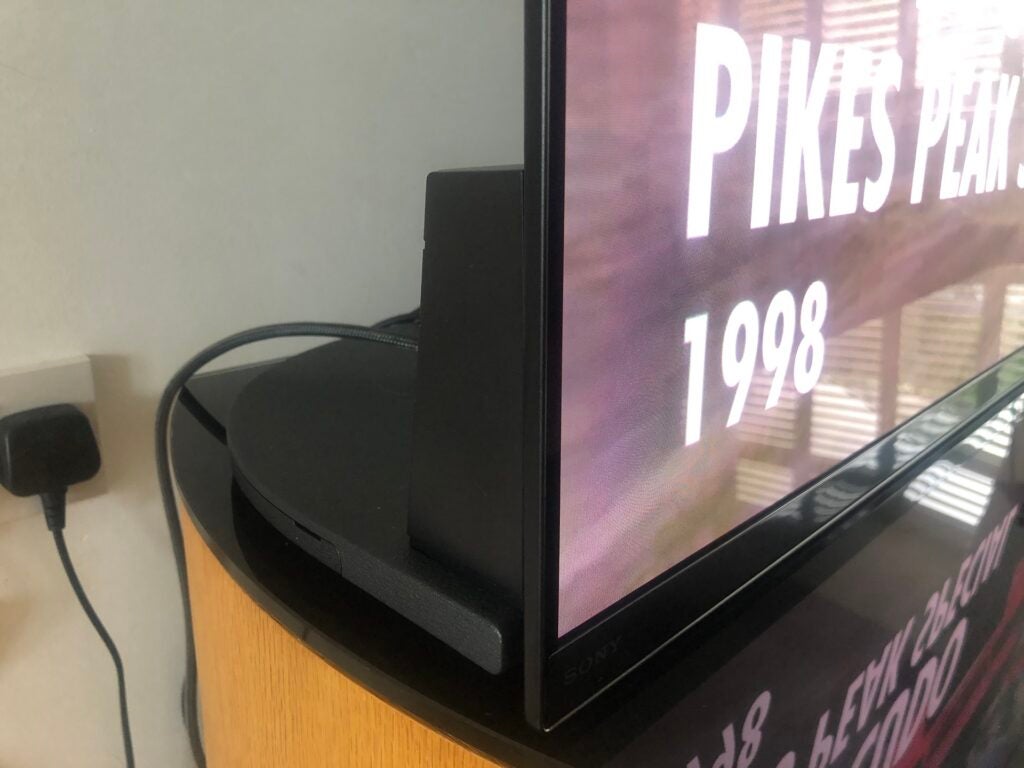
Viewed in profile, there’s very little of that OLED slimness that was a big part of the technology’s allure when it first hit the mainstream. At 43mm deep (except for a little section at the top of the screen) it looks unremarkable. The grid pattern that covers the rear panel is pleasant, though, and it allows Sony to hide the ‘pop on/pop off’ panels that cover the screen’s selection of inputs (and the cables that attach to them) more readily than some alternative designs.
The A95K can be wall-mounted, of course (it’s a touch over 21kg without its stand, mind you, so bear that in mind), but if you prefer to put it on a surface there are a couple of stand-mounting options. The stand itself is quite chunky, but if you position it behind the screen it won’t be visible at all – and the screen itself leans back just a little in the manner Sony established with the A1 OLED back in the day (2017). Alternatively, attach it to the front of the screen and it can be pushed back close to a wall – the screen stands upright when it’s arranged this way.
Features
- HDMI 2.1 with VRR, ALLM, 4K @120Hz and Auto Tone-Mapping
- Google TV interface
- Choice of remotes
The headline feature here, of course, is the A95K’s QD-OLED panel. Designed by Samsung, QD-OLED intends to address the one perceived shortcoming of OLED TV technology: brightness.
And although Samsung is currently the only brand producing QD-OLED panels, experience with regular OLED (panels of which are almost entirely produced by LG) has taught us that the panel is just the start. It’s the processing on which an OLED TV stands or falls, and it seems unlikely QD-OLED will be any different.
Sony has fitted the A95K with the full-on no-compromise ‘Cognitive Processor XR’. It was first introduced last year, but for this implementation it has undergone some tweaks – especially to its ‘Flexible Colour Contrast Control’, in an effort to exploit the increased brightness available from this new panel.
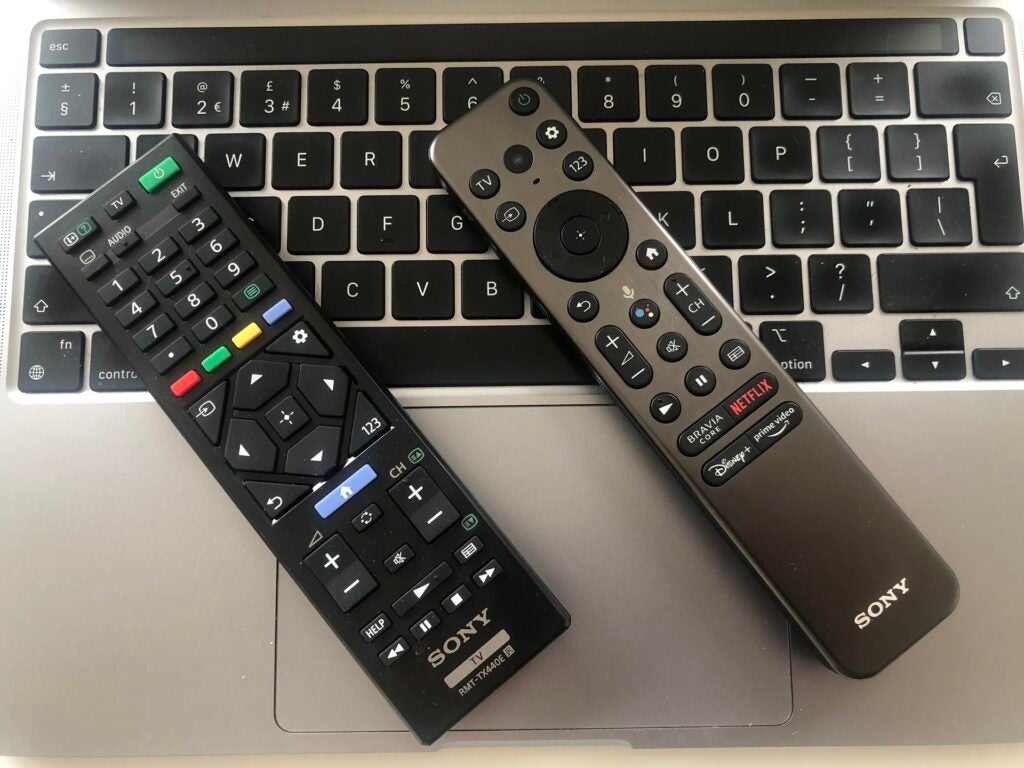
Control is available via either of the two remote control handsets the A95K ships with. As is the fashion these days, one is a small, nicely finished control that covers most major functions – and it includes hot-keys for Netflix, Disney+, Amazon Prime Video and Sony’s own Bravia Core streaming service. The other is a small, ordinarily finished alternative with too many buttons and not enough space between them.
Whichever you decide to use, it puts you in control of a Google TV smart interface. It’s a decent interface too, what’s more, one that’s not too dim when it comes to making recommendations and that’s nicely legible. It’s Google-centric, naturally enough, but the Apple TV and Netflix apps are not too far away – and with the exception of Disney+ (which goes without Dolby Atmos support) the streaming and catch-up TV services available here are the best versions of themselves.
To exploit all this high-quality content, the Sony’s 4K panel is compatible with HLG, HDR10 and Dolby Vision HDR standards. It can deal with Dolby Atmos sound, too – although its two subwoofers and two actuators (which turn the screen itself into a speaker, which has been a Sony party-piece for a while) don’t pretend to deliver an Atmos effect.
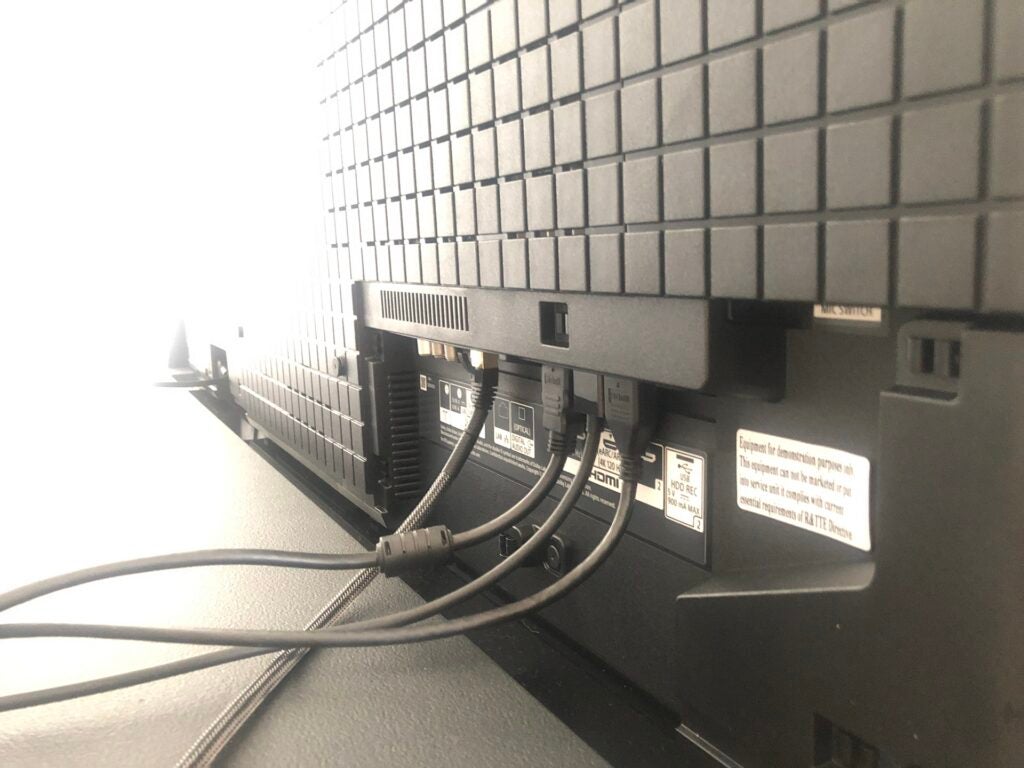
As far as connectivity is concerned, the A95K should have even the most demanding user covered. There’s Ethernet (or dual-band wi-fi, if you prefer), four HDMI sockets (two of which are at 2.1 48Gbps standard), a couple of USB inputs, two binding posts for satellite tuners and an RF equivalent. There are speaker binding posts in case you want your TV to serve as the centre channel in a surround-sound system (another Sony specialty) and a hybrid 3.5mm socket for composite video or centre-speaker input. Wireless connectivity beyond wi-fi runs to Bluetooth 4.2, Apple AirPlay and Chromecast.
All four of the Sony’s HDMI sockets support Variable Refresh Rate and Auto Low-Latency Mode, and the pair of 2.1-standard inputs also cover eARC, 4K @ 120Hz and Auto Tone Mapping. This is obviously good news for next-gen console owners.
The only other noteworthy feature is the detachable Bravia Cam that magnetically snaps into a little recess at the top of the rear of the screen and then peers over the top. One of these days, says Sony, it’ll be used for gesture control, automatic optimisation of picture settings relative to ambience, and all sorts of other magic things. For now, it’s good for chatting via Google Duo.
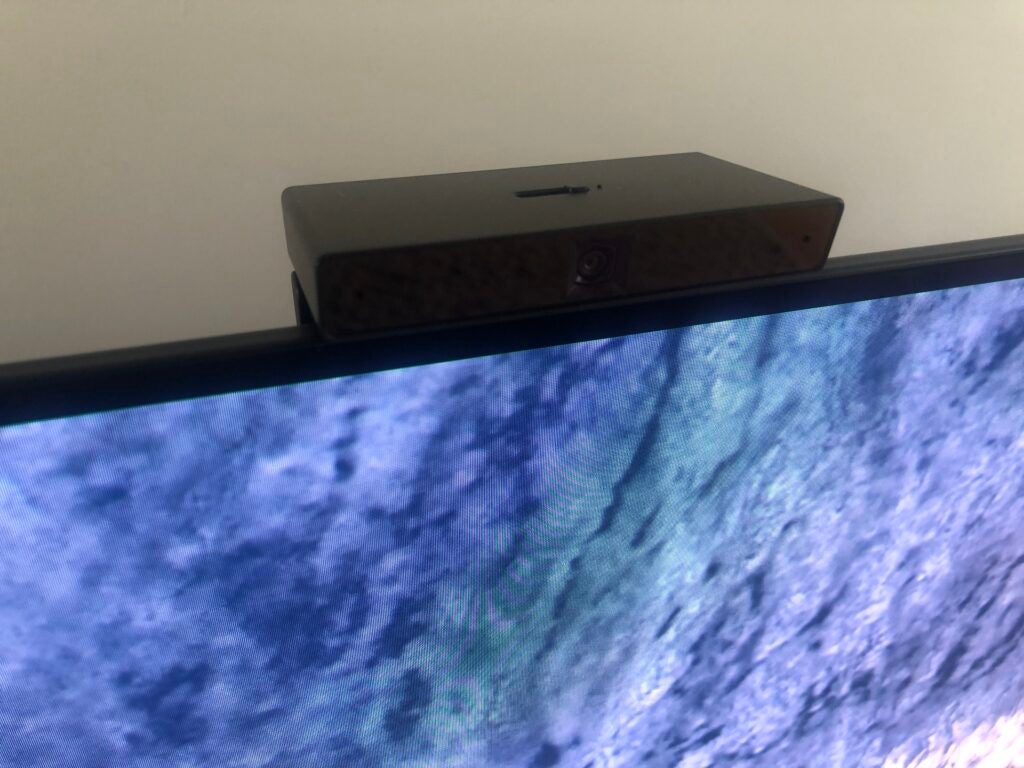
Picture Quality
- Great insight into the brightest and darkest scenes
- Outstanding motion control
- Naturalistic, convincing colour balance
Two things occur to me in very quick succession at the start of this test. The first is that the supposedly superior brightness of QD-OLED doesn’t seem that much brighter at all. The second is that the brightness this QD-OLED panel produces is superior, in colour fidelity and detail levels especially, to even the brightest non-QD OLED screens currently available.
A Netflix-derived stream of The Man from Toronto (available with Dolby Vision HDR and Dolby Atmos sound) confirms it. Even the brightest scenes (and areas of scenes) reuse to ‘white out’ and instead retain impressive amounts of detail and nicely balanced colour.
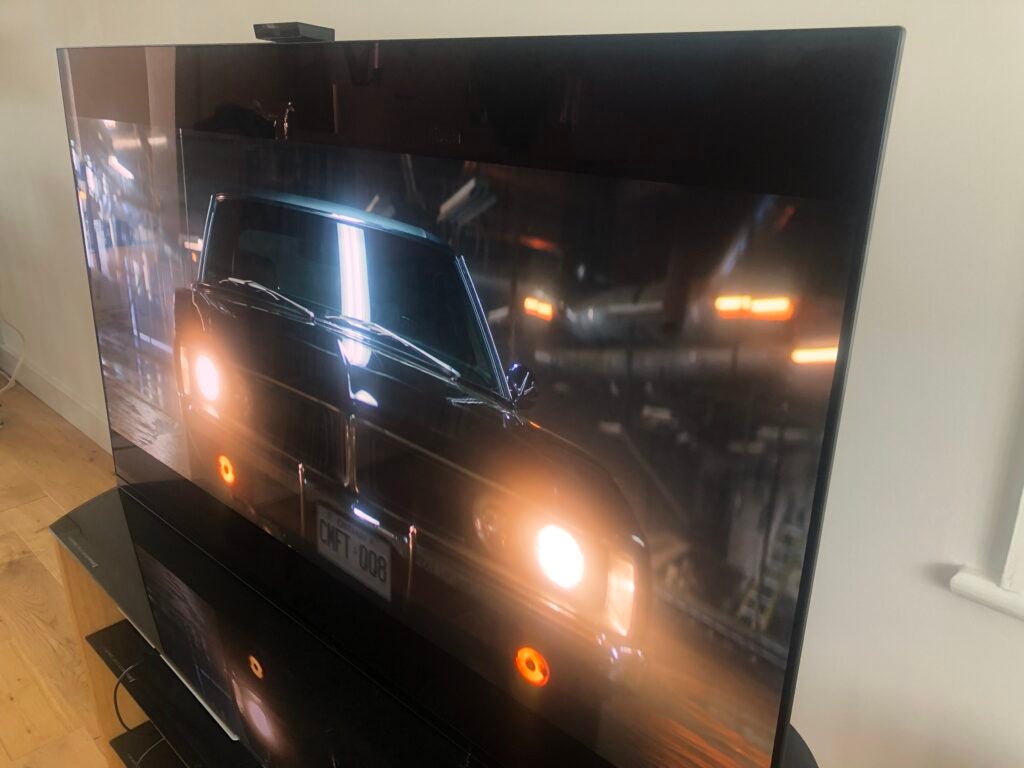
And predictably, this sort of colour fidelity and prodigious levels of detail are retained throughout brightness levels, all the way down to ‘dark’ (which, in the time-honoured OLED tradition, means ‘pitch black’). The Sony controls black tones as well as it does the bright ones, giving insight and impressive variation in even the murkiest scenes. The man from Toronto may dress in black and drive a black Dodge Charger R/T, but the A95K describes both his clothing and his car with real expertise.
The overall colour balance is enjoyably naturalistic, with skin-tones and -textures in particular enjoying proper variation within the confines of believability. Depth of field is convincing too, with the wide-open shots of the Utah desert almost three-dimensional. Edges are properly defined and shimmer-free, while even the most complicated or intricate patterns are stable.
Switching to some 4K HLG coverage of Wimbledon on the BBC demonstrates the Sony’s absolute control of motion. Like most sports, tennis is an extremely tough ask of any TV – all that rapid, small-object motion that’s usually in opposition to the movement of the camera, all happening on a big swathe of uniform colour, is difficult to keep on top of. But the A95K describes the action with absolute certainty, controlling the edges of the ball as it whizzes from the bottom of the screen to the top and back again with authority.
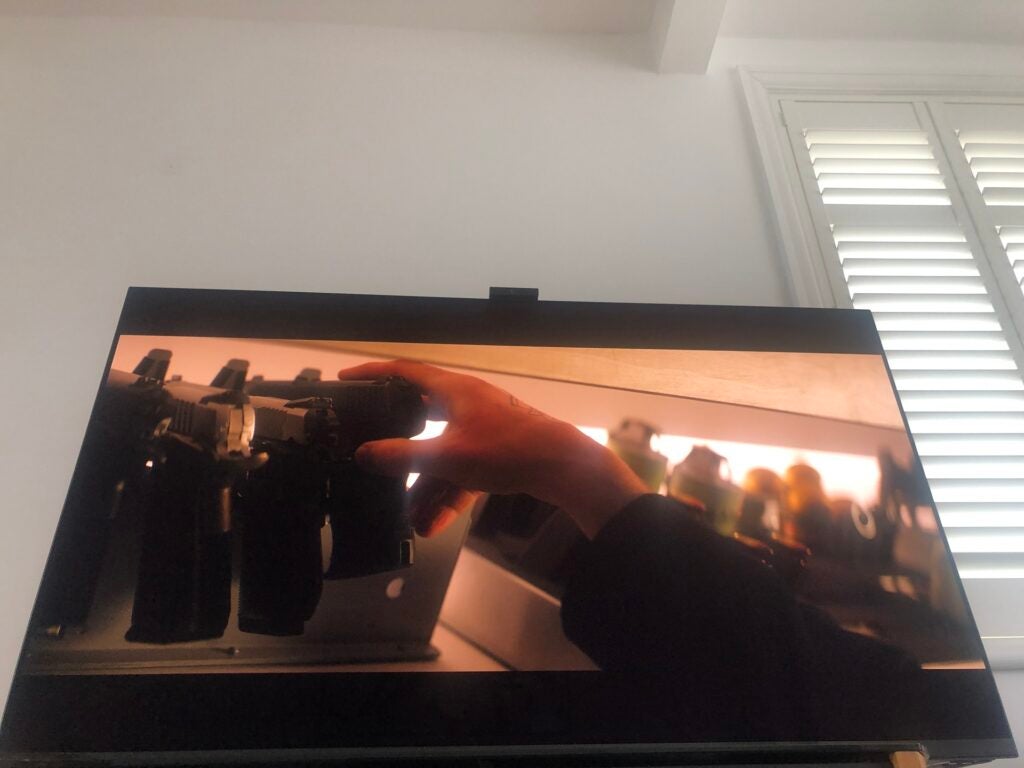
As an upscaler of lower-resolution content, the Sony is adept – but only up to a point. HD content is handled confidently, the A95K filling its pixel-count without detail levels dropping off too badly or the overall image getting particularly coarse. Step down from there, though, and the Sony can’t disguise how hard it’s having to work – images are soft and edgy at the same time, with detail retrieval seemingly more by accident than by design.
As far as gaming is concerned, the A95K gets on famously with a Playstation 5. Images are stable, bright, detailed and all that other good stuff – and while the Sony isn’t as lightning-fast in its responses as, say, an equivalent LG screen, at around 20m/s its input lag will be imperceptible to most users.
Sound Quality
- Actuators + subwoofers = big sound
- Detail and weight in equal measure
- Doesn’t immediately (or automatically) detect a soundbar
Sony’s a fan of actuators (or ‘exciters’) to the point its Acoustic Surface Audio+ is a feature of all its OLED TVs. Put simply, the screen itself is vibrated to the point that it acts as an audio speaker, and here Sony’s finessed the system for this specific QD-OLED panel. Two actuators are combined with two rear-facing subwoofers.
And by the standards of TVs that don’t charge a big premium because of their integrated Bowers & Wilkins or Technics audio systems, the A95K sounds more than acceptable. It manages to give proper weight and depth to low frequencies, without sounding strained or stressed in any way. It produces a big, well-defined sound that seems a little bigger than the screen from which it comes. Control is good, detail levels are good… and it’s capable of getting almost uncomfortably loud before its composure deserts it.
Ordinarily, even the most expensive and accomplished TVs can have their standard audio system improved by spending just a few hundred pounds on a proper soundbar. In the case of the Sony XR-55A95K, though, you’ll be looking to spend a fair bit more than that if you want to take your audio experience to the next level.
Latest deals
Should you buy it?
You’re an early adopter. Mad for cutting-edge technology? Here’s a bit
You watch a lot of daytime TV. There are limits to the Sony’s upscaling abilities
Final Thoughts
Ultimately the Sony XR-55A95K is not a game-changer. But it’s a game-advancer, no doubt about it, and for that alone it’s well worth consideration. That’s not to suggest it has the field clear, of course; you can buy a TV for a worthwhile chunk less than this and still be delighted with your purchase. The Sony is the best 55-inch TV currently available, of that I’m sure. Whether or not it’s worth its little premium is a slightly different question.
How we test
We test every televisions we review thoroughly over an extended period of time. We use industry standard tests to compare features properly. We’ll always tell you what we find. We never, ever, accept money to review a product.
Find out more about how we test in our ethics policy.
Tested for more than a week
FAQs
QD-OLED is a mixture of Quantum Dot colour filter and OLED screen that allows for a wider range of colours to be shown and higher level of brightness to be reached.








